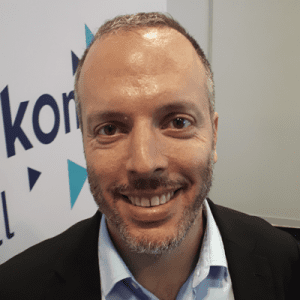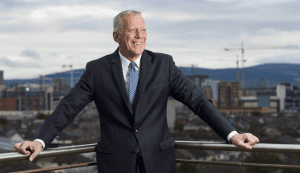 What does innovation mean, what should it do, and where should it take place? CEOs and visionaries from across the sector give their insights to PTC.
What does innovation mean, what should it do, and where should it take place? CEOs and visionaries from across the sector give their insights to PTC.
In our industry, there has probably never been a time like the present. So much innovation. So many changes. So much impact. However, beyond stating that, it’s hard to pin point what innovation really means: How should it be managed? What conditions does it need? In a time of colossal upheaval across the sector, what degree of impact will a given innovation really have?
Unquestionably, innovation itself has a foundational relevance. “Innovation is about doing new things or doing old things in new ways, and inventing technologies and methods that enable new solutions to old and new problems,” says Internet pioneer Dr. Vinton Cerf, VP at Google. Eran Haggiag, Co-Founder and Executive Chairman of Clear Blockchain Technologies, agrees a shift in perspective is inherently involved: “Innovation is the ability to look at the world from a different angle and use technology to tell a different story.” Others see innovation as essentially tackling the unknown. “At the root of innovative thinking is a relentless drive to make what is conventionally impossible probable,” says Infinera CEO Tom Fallon.
 For most CEOs, innovation remains a critical corporate function. “Innovation is at the core of what we do,” says Dinah Gueldenpfennig Weisberg, President and CEO, REDCOM Laboratories. However, discussing innovation often means discussing an elusive narrative taking in many trajectories: technology, business models, and even organizational designs.
For most CEOs, innovation remains a critical corporate function. “Innovation is at the core of what we do,” says Dinah Gueldenpfennig Weisberg, President and CEO, REDCOM Laboratories. However, discussing innovation often means discussing an elusive narrative taking in many trajectories: technology, business models, and even organizational designs.
The big picture, therefore, is a complex one. Not surprisingly, it may often be highly disruptive. PCCW Global’s CEO Marc Halbfinger explicitly links the two: “Innovation is critical because the world today by definition is constantly being disrupted. A synonym for disruption is innovation.” Within this disruption, however, consequences are unpredictable. “We may understand the technology but often we don’t understand the implications of it,” says Stephen Ho, CEO of CITIC Telecom International CPC. “We don’t understand the disruptive force of what is involved.”
The Everywhere Now Dynamic
Within this disruptive mix, there are several related drivers: in ICT, much innovation is at the same time global, networked, and infrastructural. It has the capacity to rearrange network and service economics across the sector. In an interconnected environment, a single disruptive innovation in ICT can be broadly transmitted. It has become an everywhere now dynamic with many dimensions.
One dimension sees core technologies as a once-in-a-generation upgrade practically everywhere. Improvements in optical and wireless pipes and platforms are visibly generating new capabilities throughout and across the entire value chain.
“Nowhere is this more critical,” says Infinera’s Tom Fallon, “than in the field of optical networking which requires continuous innovation – innovation that drives the network economics that allow the creation of new applications which create an explosion of bandwidth demand across long haul, subsea, and metro networks.”
He continues: “The physics of fiber optic communications has always been complex, but as networks scale to wavelength speeds of 600+ gigabits per second, that complexity only increases. At Infinera, our focus remains on pushing the boundaries of convention with unique vertical integration and optical layer automation that have moved beyond the probable as we continue to set proven benchmarks in price-performance, operational simplicity, and service agility.”
Equally, innovation in the wireless domain, particularly in 5G, will also clearly push the envelope for many other activities. Upgraded capability will likely spur more infrastructural development and spin off technologies—if the conditions are right. “5G is one of the most important innovations of the 21st century,” declares Malcolm Johnson, ITU Deputy Secretary-General. “It will underpin the digital economy and bring substantial social, economic and environmentally sustainable benefits.” It requires the right bedrock environment for full exploitation, he says: globally harmonized spectrum and standards will encourage investment, ensure interoperability, and reduce costs.
 But the disruptions underway could extend much further. Other powerful shifts with the potential to dramatically retool and rearchitect service economics are also emerging. “Blockchain, while initially created as a base for Bitcoin, has inspired myself and others, to reimagine the entire financial operating system,” says Eran Haggiag of Clear Blockchain Technologies. “This has paved the way for decentralized global trade grids that allow frictionless, on-demand, low cost and secure B2B trade, support multiple business models, and accelerate innovation across global industries.”
But the disruptions underway could extend much further. Other powerful shifts with the potential to dramatically retool and rearchitect service economics are also emerging. “Blockchain, while initially created as a base for Bitcoin, has inspired myself and others, to reimagine the entire financial operating system,” says Eran Haggiag of Clear Blockchain Technologies. “This has paved the way for decentralized global trade grids that allow frictionless, on-demand, low cost and secure B2B trade, support multiple business models, and accelerate innovation across global industries.”
In short, it is entirely possible that the sequence of innovations we currently see has the power to reorder the business landscape in its totality. This reordering and structural change, particularly within service providers themselves, may consequently offer further opportunities, says Larry Schwartz, Chairman and CEO of Seaborn Networks. He suggests: “Continued innovation is critical to the future success of the wholesale telecom industry. Our focus is on providing innovations to the business model for system development, operations, and sales. As international telcos increasingly prioritize their retail businesses over network infrastructure ownership, it creates a gap in the market to fill as a customer-focused, subject-matter expert.”
 This is not without its challenges, particularly in staying competitive. Many service providers say the pressure is on to achieve better economics but also improved differentiation in provision of services. Carl Grivner, CEO of Colt Technology Services, points out, “Innovation is a big part of it because we all buy the underlying glass and electronics and back office stuff from the same companies. It is how you integrate them together into an overall package and provide innovation on top that will differentiate you in the marketplace.”
This is not without its challenges, particularly in staying competitive. Many service providers say the pressure is on to achieve better economics but also improved differentiation in provision of services. Carl Grivner, CEO of Colt Technology Services, points out, “Innovation is a big part of it because we all buy the underlying glass and electronics and back office stuff from the same companies. It is how you integrate them together into an overall package and provide innovation on top that will differentiate you in the marketplace.”
The People Piece
CEOs seem acutely aware that no worthwhile and sustainable innovation can happen without a facilitating and motivating culture backing it up. All of which, say thought leaders, means the people dimension probably matters more now than ever. “The challenge—and satisfaction—of solving unique customer problems is what energizes us each and every day,” says REDCOM Laboratories’ Dinah Gueldenpfennig Weisberg. She continues: “Innovation isn’t just about R&D, though. It can take many forms, but to me the people within an organization are the ultimate driver. Therefore, if you want to develop game-changing ideas that make the world a better place, take time to develop your culture and empower your team.”
This often is best fostered through a deliberate diversity of effort, says Gary Smith, CEO at Ciena. “I think innovation happens when you have the right people working on solving a business problem. Different perspectives, experiences, and an innate drive to collaborate.” His recipe: “Focus on the people and innovations are abundant.”
 Mark Dankberg, Chairman and CEO of Viasat, concurs. “It’s about personal growth, enthusiasm, excitement [and] really wanting to have a purpose to what you are doing. I think lots of people feel the same way. They are looking for outlets [for those aspirations]. In an industry where things are changing so fast and you can see opportunities to make things better for so many people, then there’s an environment where you can do that.”
Mark Dankberg, Chairman and CEO of Viasat, concurs. “It’s about personal growth, enthusiasm, excitement [and] really wanting to have a purpose to what you are doing. I think lots of people feel the same way. They are looking for outlets [for those aspirations]. In an industry where things are changing so fast and you can see opportunities to make things better for so many people, then there’s an environment where you can do that.”
He continues: “If you can help people see what’s possible and then do it in a way that they have some success and you build momentum, then that’s a really powerful force. That’s the guiding principle. One lesson is to be ambitious, but not reckless, but [also] not to be too conservative or too incremental. Even incremental change is hard [to do], but not that rewarding. The more ambitious things—if they are possible—are a lot more rewarding because it makes the whole cycle work better.”
Mr. Dankberg concludes, “Likewise, if you have something that will have an impact on the world, then you don’t want to do just a little of it because someone else will do the rest. So, it is figuring out what to do and doing the right size, not too much and not too little.”
Occasionally, this means accepting failure, too. This is perhaps innovation’s biggest request of organizations that place innovation at the core of their business in a time when growth prospects and new market opportunities have never been more evident. Ciena’s Gary Smith says, in considering leadership, he frequently ponders on a landmark study at Google that showed, in terms of getting superior team performance on innovative projects, how team members interacted was more important than who was on the team. Moreover, the ultimate dynamic of all unearthed by the study, was that successful teams invariably felt able to take risks without members feeling embarrassed or insecure.
 It’s a remarkable, even ironic, insight that in a world of high technology, human feeling counts a great deal. Vinton Cerf, with a lifetime of innovation under his belt, muses the freedom to fail is a logically useful one as well: “The freedom to take risks is an inherent aspect of innovation. Failure is often a trigger for innovative thinking.”
It’s a remarkable, even ironic, insight that in a world of high technology, human feeling counts a great deal. Vinton Cerf, with a lifetime of innovation under his belt, muses the freedom to fail is a logically useful one as well: “The freedom to take risks is an inherent aspect of innovation. Failure is often a trigger for innovative thinking.”
The 2019 PTC Innovation Awards will Honor the Future of ICT
The PTC Innovation Awards were established to recognize the individuals and companies and the excellence they are achieving in the ICT industry. By purchasing a ticket to the 2019 PTC Innovation Awards Gala, you can directly support PTC’s mission and key community outreach initiatives. Join us Tuesday, 22 January 2019, as we celebrate the leaders in innovation across the industry.




